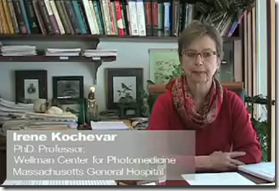So far the procedure has been used with 31 patients with skin cancers and suspicious moles. The three-to-five-centimeter excisions were closed with sutures on one side and photochemical tissue bonding on the other. Plans are soon to submit to the U.S. Food and Drug Administration for  approval, so additional clinical trials can be started, as right now they are in the pre-clinical stage.
approval, so additional clinical trials can be started, as right now they are in the pre-clinical stage.
“Animal experiments have already shown the technique to be useful in nerve, eye, and blood vessel surgeries, among others--so useful, in fact, that Kochevar and Redmond have surgeons ready and waiting to start human trials the moment the hospital approves them.”
The obvious benefits for the patient are minimize scarring and perhaps speed healing. Perhaps sutures as we know them today could become a thing of the past in time. BD
A full presentation video can be watched here to see more of what this is all about.
Despite medicine's inestimable progress over the past century, surgery can still leave scars that look more appropriate to Frankenstein's monster than to the beneficiary of a precise, modern operation. But in the Wellman Center for Irene Kochevar and Robert Redmond have developed a method that has the potential to replace the surgeon's needle and thread. Using surgical lasers and a light-activated dye, the researchers are prompting tissue to heal itself.
Laser-bonded healing is not a new idea. For years, scientists have been trying to find ways to use the heat generated by lasers to weld skin back together. But they've had a difficult time finding the right balance. Too little heat and a wound won't heal; too much and the tissue dies. Eight years ago, one of Kochevar and Redmond's colleagues was examining pathology slides of cells killed by this kind of thermal healing when it occurred to him that it might be possible to use just the light of a laser, rather than its heat.
"It's a very interesting technology, which would be useful to anyone who does any kind of skin surgery--plastic surgeons, dermatologists," says Robert Stern, a professor of dermatology at Harvard Medical School and chief of dermatology at Beth Israel Deaconess Medical Center in Boston. He notes that the technology must still prove itself, and he isn't yet convinced that the benefits will offset the costs of photochemical dyes and laser equipment, which are far pricier than a needle and thread. But, he says, the potential to minimize scarring and perhaps speed healing "could be nice for patients and improve outcomes [too]."
Technology Review: Laser Show in the Surgical Suite
Related Reading:





0 comments :
Post a Comment